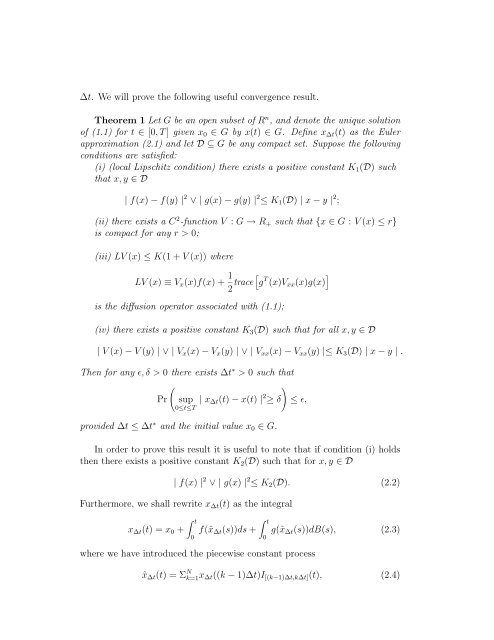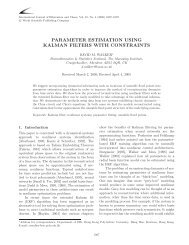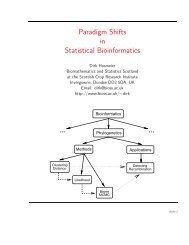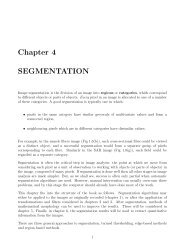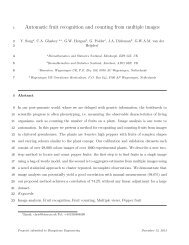Convergence of the Euler Scheme for a Class of Stochastic ...
Convergence of the Euler Scheme for a Class of Stochastic ...
Convergence of the Euler Scheme for a Class of Stochastic ...
Create successful ePaper yourself
Turn your PDF publications into a flip-book with our unique Google optimized e-Paper software.
∆t. We will prove <strong>the</strong> following useful convergence result.<br />
Theorem 1 Let G be an open subset <strong>of</strong> R n , and denote <strong>the</strong> unique solution<br />
<strong>of</strong> (1.1) <strong>for</strong> t ∈ [0, T ] given x 0 ∈ G by x(t) ∈ G. Define x ∆t (t) as <strong>the</strong> <strong>Euler</strong><br />
approximation (2.1) and let D ⊆ G be any compact set. Suppose <strong>the</strong> following<br />
conditions are satisfied:<br />
(i) (local Lipschitz condition) <strong>the</strong>re exists a positive constant K 1 (D) such<br />
that x, y ∈ D<br />
| f(x) − f(y) | 2 ∨ | g(x) − g(y) | 2 ≤ K 1 (D) | x − y | 2 ;<br />
(ii) <strong>the</strong>re exists a C 2 -function V : G → R + such that {x ∈ G : V (x) ≤ r}<br />
is compact <strong>for</strong> any r > 0;<br />
(iii) LV (x) ≤ K(1 + V (x)) where<br />
LV (x) ≡ V x (x)f(x) + 1 2 trace [ g T (x)V xx (x)g(x) ]<br />
is <strong>the</strong> diffusion operator associated with (1.1);<br />
(iv) <strong>the</strong>re exists a positive constant K 3 (D) such that <strong>for</strong> all x, y ∈ D<br />
| V (x) − V (y) | ∨ | V x (x) − V x (y) | ∨ | V xx (x) − V xx (y) |≤ K 3 (D) | x − y | .<br />
Then <strong>for</strong> any ɛ, δ > 0 <strong>the</strong>re exists ∆t ∗ > 0 such that<br />
Pr<br />
(<br />
sup | x ∆t (t) − x(t) | 2 ≥ δ<br />
0≤t≤T<br />
provided ∆t ≤ ∆t ∗ and <strong>the</strong> initial value x 0 ∈ G.<br />
)<br />
≤ ɛ,<br />
In order to prove this result it is useful to note that if condition (i) holds<br />
<strong>the</strong>n <strong>the</strong>re exists a positive constant K 2 (D) such that <strong>for</strong> x, y ∈ D<br />
| f(x) | 2 ∨ | g(x) | 2 ≤ K 2 (D). (2.2)<br />
Fur<strong>the</strong>rmore, we shall rewrite x ∆t (t) as <strong>the</strong> integral<br />
x ∆t (t) = x 0 +<br />
∫ t<br />
0<br />
f(ˆx ∆t (s))ds +<br />
where we have introduced <strong>the</strong> piecewise constant process<br />
∫ t<br />
0<br />
g(ˆx ∆t (s))dB(s), (2.3)<br />
ˆx ∆t (t) = Σ N k=1x ∆t ((k − 1)∆t)I [(k−1)∆t,k∆t] (t), (2.4)


